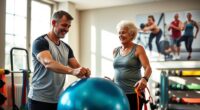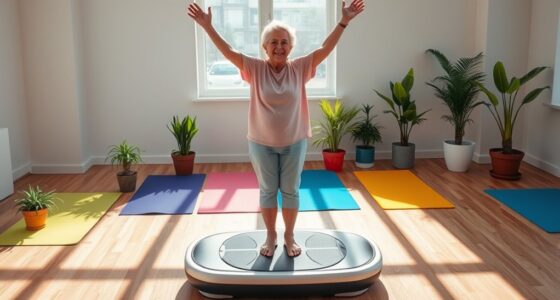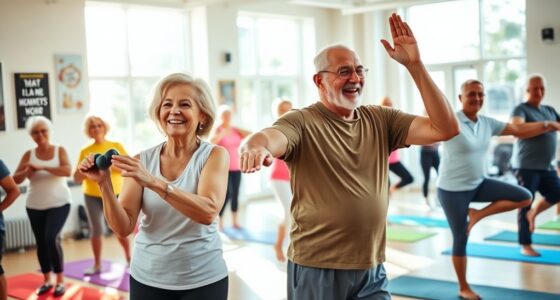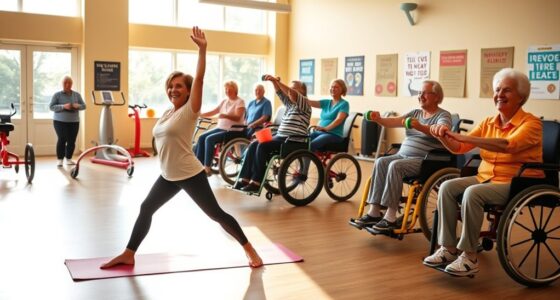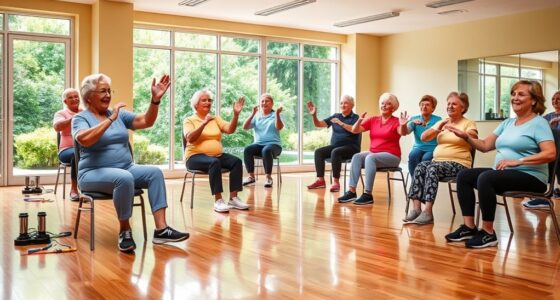Leg exercises are essential for you as a senior to build strength and stability. They enhance mobility, improve balance, and reduce your risk of falls. Try incorporating chair squats, seated leg extensions, and calf raises into your routine. Remember to prioritize safety by consulting a healthcare provider and using supportive equipment. With regular practice, you’ll notice improved independence in daily activities. Explore more exercises and tips to enhance your leg strength and overall well-being.
Key Takeaways
- Chair squats and seated leg extensions effectively strengthen quads and glutes with minimal joint strain for seniors.
- Calf raises enhance calf strength and improve balance, crucial for mobility in daily activities.
- Reverse lunges engage glutes and promote stability, making them ideal for improving overall leg strength.
- Use sturdy supports like chairs to maintain balance during exercises and reduce fall risks.
- Aim to incorporate leg exercises 2-3 times a week for optimal strength and stability benefits.
The Importance of Leg Exercises for Seniors
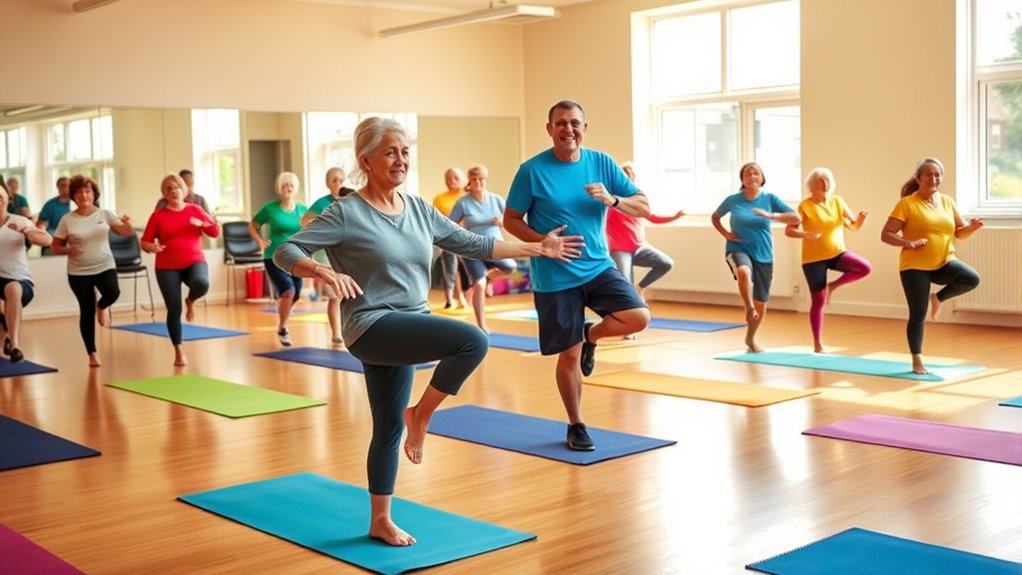
As you age, it’s vital to prioritize leg exercises since they play an important role in enhancing your mobility and balance.
For seniors, maintaining strength in your legs can greatly reduce the risk of falls and injuries, allowing you to stay independent in daily activities like walking and climbing stairs. Engaging in regular leg exercises not only supports essential muscle strength but also promotes joint health, alleviating pain from conditions like osteoarthritis. Additionally, weight-bearing leg workouts improve bone density, lowering the chances of osteoporosis-related fractures. Consistent leg strengthening routines also boost cardiovascular health and circulation, essential components of your overall physical well-being. Furthermore, understanding long-term financial planning for assisted living needs can motivate seniors to stay active and engaged in their physical health. Incorporating physical activity into daily routines can further enhance mental clarity and emotional well-being. Regular exercise can also help manage sleep challenges that many seniors face, contributing to a more restful night. Moreover, maintaining physical activity can lead to improved retirement savings plans as seniors may find they can live independently for longer, reducing future assisted living costs. It’s important to recognize the unique emotional needs of seniors, as staying active can also support their mental health during challenging life transitions.
Top Leg Exercises to Enhance Strength
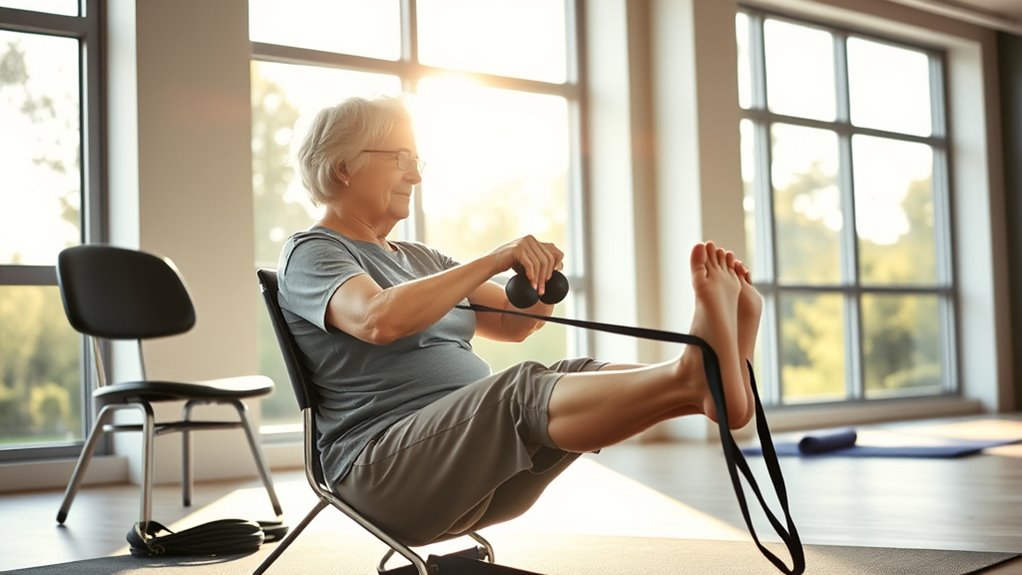
Incorporating just a few key leg exercises into your routine can make a significant difference in your strength and stability. Engaging in continuous learning about fitness can further enhance your exercise effectiveness. Here are some of the best leg strengthening exercises for seniors that not only enhance muscle mass but also improve balance:
| Exercise | Benefits | How to Perform |
|---|---|---|
| Chair Squats | Strengthens glutes, quads, hips | Stand, sit, and rise |
| Seated Leg Extensions | Targets quads, low joint strain | Extend legs while seated |
| Calf Raises | Strengthens calves | Raise heels while standing |
| Reverse Lunges | Engages glutes, improves balance | Step back, lower body |
These exercises contribute to your overall health and wellness while ensuring safety in daily activities. Engaging in regular physical activity can also help promote resilience and enhance your mental well-being. Additionally, understanding early socialization is crucial for maintaining balance and coordination as we age, as it can also help reduce the risk of tick-borne diseases. Moreover, adopting a growth mindset can empower seniors to embrace new exercises and adapt to changing fitness levels.
Safety Tips for Exercising
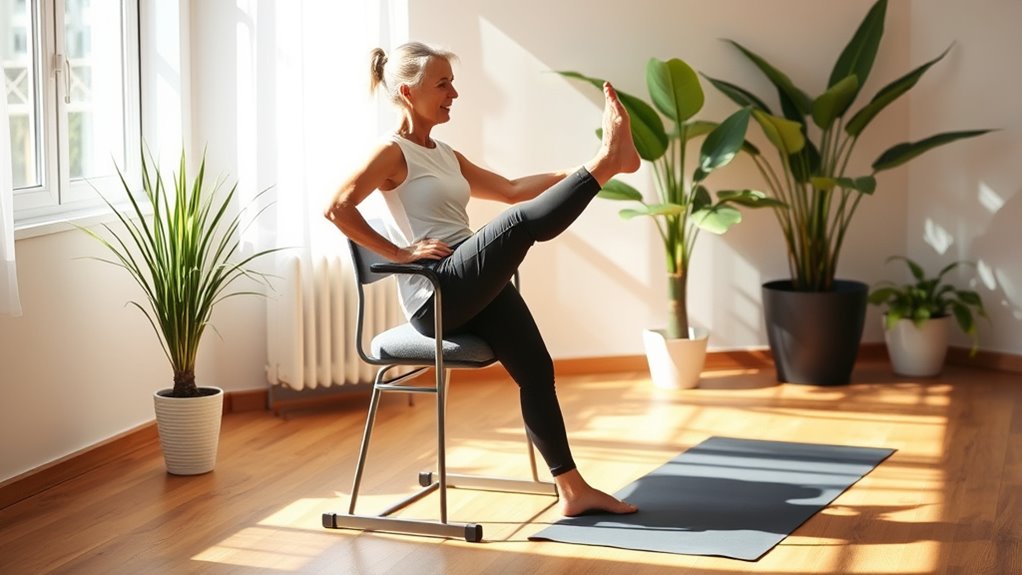
Before you start any new exercise routine, it’s important to consult your healthcare provider, especially if you have any chronic conditions. Always prioritize proper form to prevent injuries, and use supportive equipment like a chair for added stability. Additionally, understanding the importance of advance directives can help you communicate your health preferences effectively in case of emergencies. Incorporating hydration into your routine is also essential, as staying well-hydrated can enhance your exercise performance and recovery. Taking these precautions will help keep your workouts safe and effective. Additionally, ensuring you maintain a proper diet can support your overall health and enhance your exercise results. It’s also beneficial to monitor your credit score to ensure financial stability, which can reduce stress and contribute to overall well-being. Furthermore, engaging in regular physical activity can significantly lower the risk of chronic conditions that may affect your quality of life.
Consult Healthcare Provider First
Consulting a healthcare provider is essential when starting an exercise program, especially for seniors dealing with chronic conditions or previous injuries.
Discuss any balance issues or physical limitations you have to receive personalized guidance that guarantees safety and appropriateness. Your healthcare provider can help you set realistic exercise goals based on your current health status, fundamental for maintaining motivation and safety. Additionally, be aware that narcissistic relationships can impact mental health, which in turn can affect physical well-being. Individuals with certain mental health disorders, such as Borderline Personality Disorder, may also face additional challenges in maintaining a consistent exercise routine. It’s important to understand that emotional detachment can also influence one’s motivation to engage in physical activities. Moreover, staying active can significantly improve hearing health, which is crucial for overall well-being in seniors.
It’s imperative to inform them about any medications you’re taking, as some may affect your physical activity tolerance or balance. Additionally, be aware of the importance of regular screenings for early detection of potential health issues, which can further inform your exercise routine.
Regular check-ins can help monitor progress and allow for necessary adjustments to your exercise routine, minimizing fall risk and enhancing your overall health.
Taking these steps can make your exercise journey more effective and secure.
Prioritize Proper Form
When you prioritize proper form during leg exercises, you greatly reduce the risk of injury while maximizing the effectiveness of your workouts. Focus on maintaining a straight back and aligning your knees with your toes during movements like squats and lunges to protect your joints and enhance performance. To further support joint health, consider incorporating proper hydration into your routine, as it plays a vital role in maintaining overall physical function. Additionally, engaging in cost-effective renovation options can help create a safe and comfortable exercise environment at home.
It’s also beneficial to recognize that joint health is crucial for maintaining mobility and strength as you age. Establishing clear co-parenting rules can provide a supportive atmosphere, helping seniors stay active and engaged in their exercise routines. Start with low-intensity exercises, gradually increasing difficulty to allow your body to adapt and prevent overexertion. For seniors, using sturdy support, like a chair or wall, can considerably improve balance and stability, especially if you have mobility concerns. Always listen to your body, and remember that proper form is key to building strength and ensuring safe, enjoyable exercise sessions. Additionally, incorporating emotional intelligence into your workout routine can help you remain aware of your body’s signals and adjust your exercises accordingly.
Use Supportive Equipment
To safely enhance your leg workouts, using supportive equipment can make a significant difference. Incorporating sturdy chairs and resistance bands boosts stability, helping you maintain proper form and reduce the risk of falls during low-impact exercises. Additionally, using safety features like those found in heated mattress pads can provide reassurance while exercising, as they demonstrate the importance of incorporating reliable equipment in any activity. Regularly checking and maintaining air purifier filters ensures a clean environment, which can enhance your overall exercise experience.
Wearing supportive footwear with non-slip soles further improves your balance and prevents slipping. Engaging in seated exercises, like seated knee extensions, allows you to strengthen your legs with minimal strain or risk of losing balance.
Additionally, performing exercises near walls or countertops provides extra support as you build strength and stability. Gradually increasing the use of supportive equipment can lead to a smoother shift to more advanced exercises, promoting a healthy lifestyle and boosting your confidence over time. Moreover, understanding the importance of proper form can significantly enhance safety and effectiveness during your workouts.
Modifying Exercises for Individual Needs
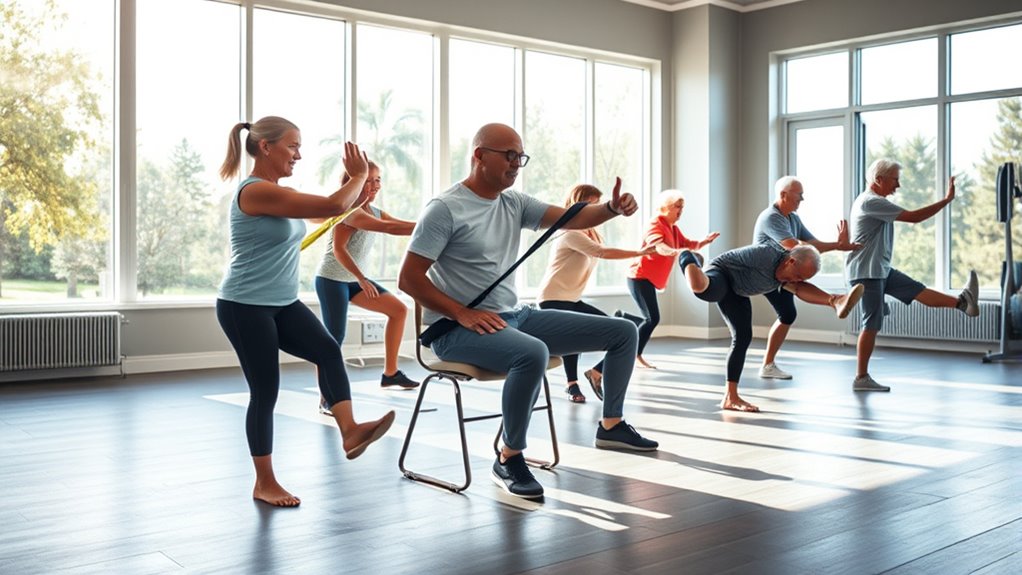
Modifying exercises for individual needs is essential for seniors, as it guarantees safety and accommodates varying fitness levels.
You can use a sturdy chair for support during exercises like lunges or squats, helping you maintain balance and confidence. Adjusting your range of motion based on comfort enhances effectiveness without risking joint strain.
Incorporating resistance bands provides additional support; you can easily adjust the resistance to match your strength. For those who prefer a seated position, exercises like seated leg extensions reduce strain on your joints and make strength training more accessible.
Incorporating Leg Exercises Into Your Routine
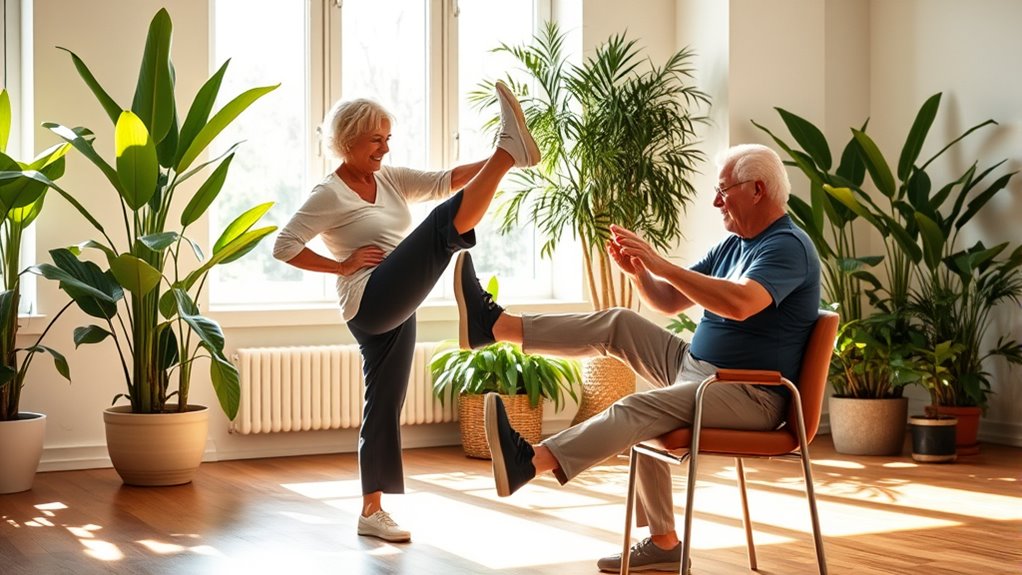
Incorporating leg exercises into your routine can be a game changer for your overall health and mobility. Aim to include strengthening exercises for seniors at least 2-3 times a week.
Start with simple activities like chair squats and seated leg extensions, gradually increasing intensity as you build strength. This approach not only supports overall leg health but also plays an essential role in maintaining mobility and reducing the risk of falls.
To stay motivated, set achievable goals and track your progress consistently. Don’t hesitate to leverage community resources, such as senior fitness programs or online tutorials, to guide your exercise for seniors.
With commitment and the right support, you’ll see improvements in your strength and stability.
Benefits of Regular Leg Exercise for Seniors
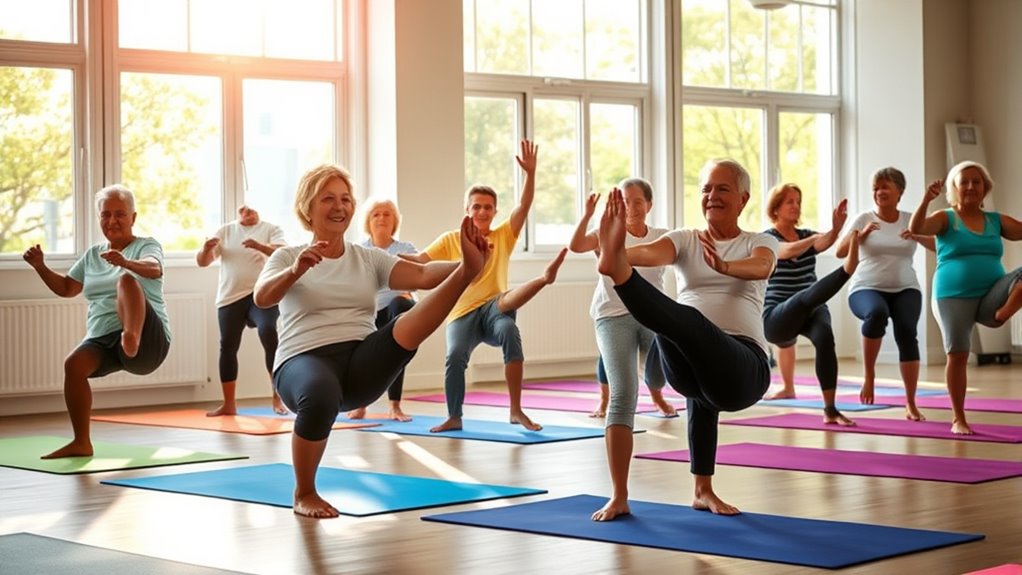
As you engage in regular leg exercises, you’ll discover a multitude of benefits that enhance your overall well-being.
Here are some key advantages:
- Improved Mobility and Balance: Strengthening your legs reduces fall risks by enhancing stability.
- Increased Independence: You’ll perform daily tasks like walking and climbing stairs with ease.
- Better Joint Health: Leg exercises enhance flexibility and reduce stiffness, benefiting those with osteoarthritis.
- Boosted Cardiovascular Health: Improved circulation supports heart health and reduces the risk of conditions like deep vein thrombosis.
Frequently Asked Questions
How to Increase Leg Strength in Seniors?
To increase leg strength, you should focus on a mix of exercises that challenge your muscles.
Try incorporating squats and lunges into your routine at least 2-3 times a week. You can also add seated exercises like knee extensions for safety.
Using resistance bands or light weights will further enhance your workouts.
Make sure you track your progress and adjust the intensity based on how you feel, keeping your motivation high!
What Is the Best Leg Exerciser for Seniors?
Imagine gliding smoothly on a recumbent elliptical, your legs moving rhythmically while feeling the gentle support around you.
The best leg exerciser for you combines adjustable resistance with stability features, ensuring a safe workout. A seated leg extension machine is ideal, isolating your quadriceps while you sit comfortably.
Don’t forget resistance bands; they’re versatile and let you gradually increase strength at your own pace.
Choose what feels right, and let your legs grow stronger!
What Is the Best Exercise to Strengthen Weak Legs?
To strengthen weak legs, you can’t go wrong with the reverse lunge. It engages your glutes, quads, and hamstrings, helping to build overall leg strength.
Plus, it promotes balance, which is essential for everyday movements. If you’re looking for something simpler, chair squats are great too, offering support while targeting your thighs and glutes.
Incorporating these exercises into your routine will lead to noticeable improvements in strength and stability.
How Can I Build Leg Muscle After 70?
Building those bold leg muscles after 70 isn’t just possible; it’s practical!
You can start by incorporating simple exercises like chair squats and calf raises into your weekly routine. Aim for 2-3 sessions each week, focusing on form to avoid strain.
Adding resistance bands or light weights can amplify your efforts, too. Don’t forget to munch on protein-rich foods, as they’re essential for muscle repair and growth.
Keep it consistent, and you’ll see results!
Conclusion
Just like a sturdy tree needs strong roots to withstand the winds, you too need strong legs to support your daily activities. By embracing these leg exercises, you’re planting seeds of strength and stability that will help you flourish. Remember, it’s not just about moving; it’s about building a solid foundation for your golden years. So, nurture your legs, stay active, and watch as you grow stronger, ready to face whatever life throws your way.

